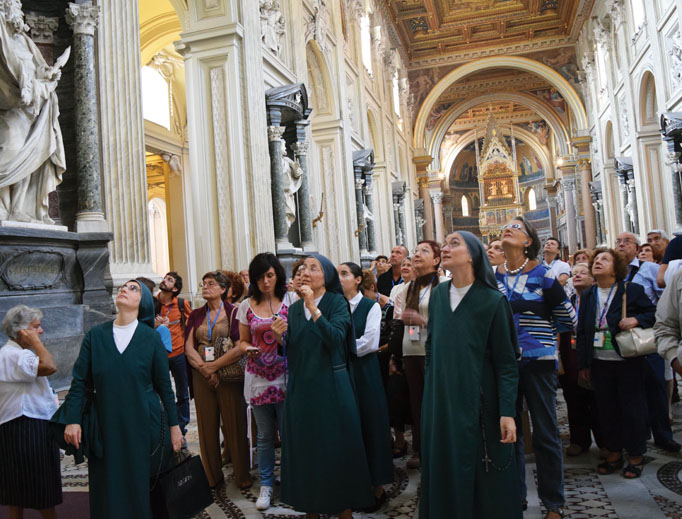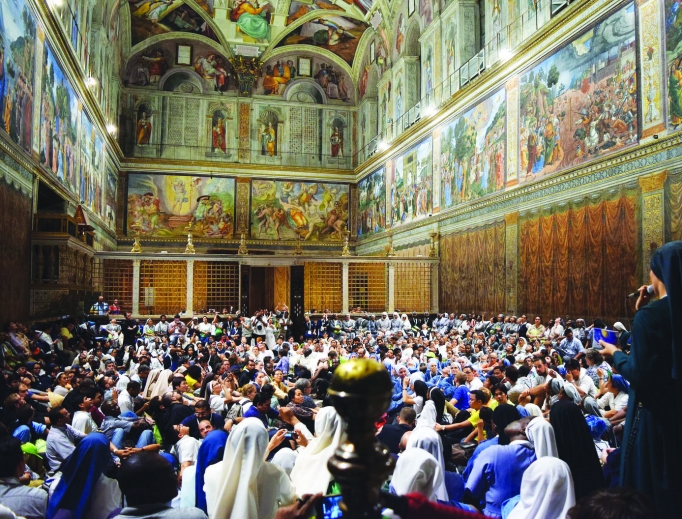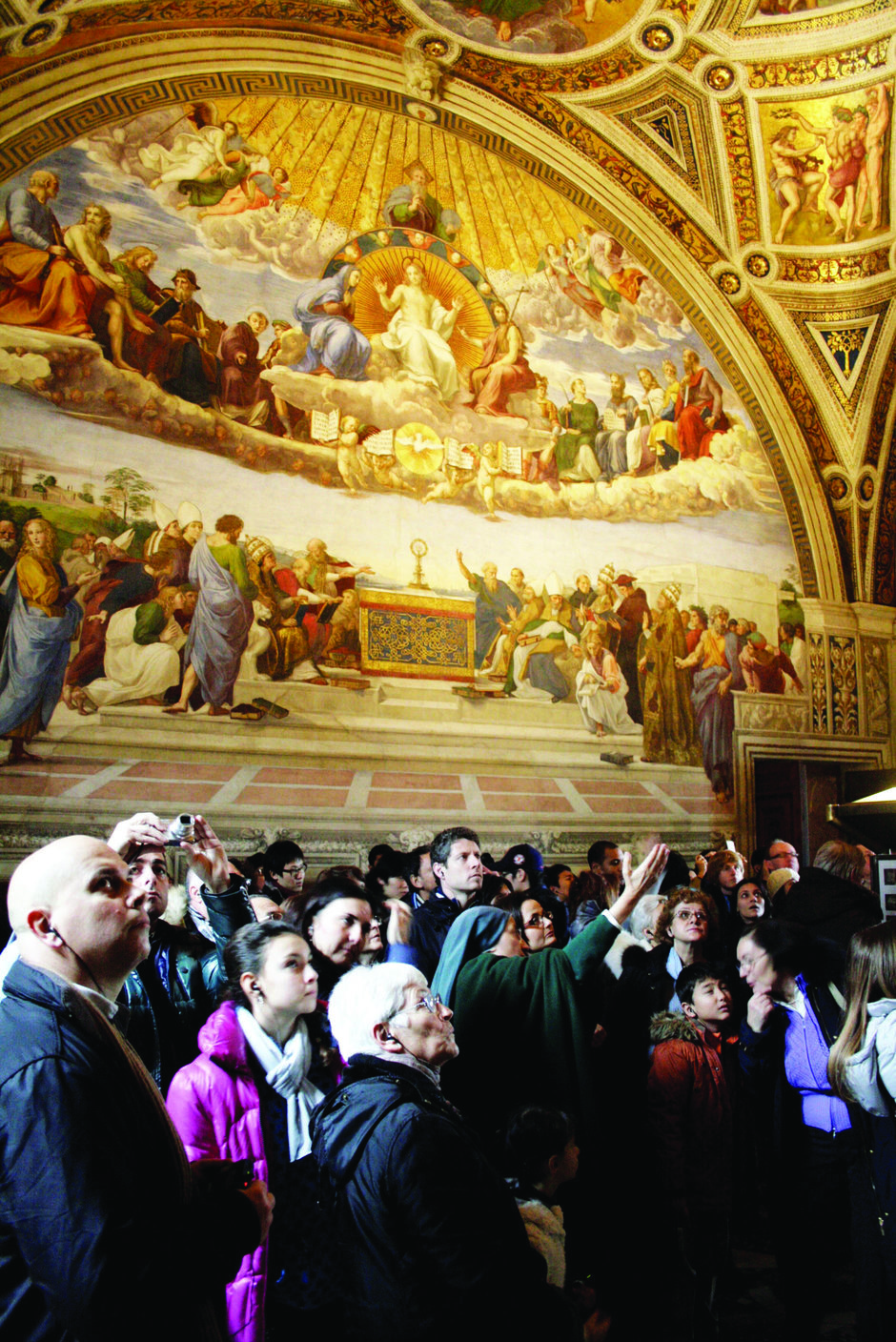Tour Guides for Beauty: How the ‘Green Sisters’ Share the Power of Art
The Missionaries of the Divine Revelation serve as guides for pilgrims in Rome, explaining the Catholic faith through timeless masterpieces and sacred images.

In the past few years, the Suore Verdi (“Green Sisters”) have become emblematic figures of the many beautiful religious monuments of Rome. If some people associate the color of their habit to some environmental spiritual movement, this green is meant to recall the mantle of the Virgin of the Divine Revelation, who appeared to anti-Catholic Bruno Cornacchiola in a grotto at Tre Fontane (“Three Fountains”) in Rome, on April 12, 1947.
This young community of sisters, called the Missionaries of the Divine Revelation, was born at the end of the 20th century under the impetus of Mother Prisca and received diocesan approval on Feb. 11, 2001. This small Roman community quickly made itself known through its original apostolate, which is the diffusion of the Catholic faith through art.
“Our Marian charism, our interior life and spiritual nourishment, flow into our apostolate,” Sister Agnese Scavetta, a nun of the community, told the Register. Sister Agnese is one of the emblematic figures of “Catechesis With Art,” a program that allows the faithful and pilgrims to discover the Eternal City’s heritage through the memory of the apostles and the saints.
“Living in Rome, we realized that going to the very places where the Catholic faith was sown, where the stories of the saints and martyrs took place, using the marvelous churches and artworks, was an efficient way to transmit the teachings of the Church,” she said.
Everything started in the Archbasilica of St. John Lateran, where, in 2001, Cardinal Camillo Ruini, vicar general of the Diocese of Rome, asked the sisters to decode the religious meaning of the monument’s artworks for the faithful.
While contemplating the treasures of the central nave, they understood the narrative dimension of art was a privileged path to evangelization. In 2007, Cardinal Angelo Comastri asked them to write texts for the audio guides of St. Peter’s Basilica; and in 2009, the Green Sisters were asked to lead the pilgrims’ visits in the basilica. The Missionaries are now the official guides of both St. Peter’s and the Vatican Museums, within the framework of “Art and Faith Itineraries,” which exist in Italian, English and Spanish. The pilgrim groups comprise as many as 200 people.



The Missionaries have become icons of religious art history, and their expertise is more and more sought by the media and believers from all over the world. And the atypical personalities making up the community certainly have something to do with that. Mother Superior Rebecca Nazzaro, ex mezzo-soprano of the Lyric Choral of Rai, gave up a prestigious career, a career she loved, to follow Jesus.
“I was educated to beauty in my childhood, to nature’s beauty, but I used to wonder why beauty always had to fade eventually,” Mother Rebecca told the Register.
“One day, I understood that the beauty I desired to see in music, the ideal of beauty that I desired to reach for myself, for my youth and body, came from a greater desire because real beauty is God that never fades. God is a flower that never fades,” she said.
“Beauty has the ability to waken in our hearts a longing for God, for something eternal, which never ends,” Sister Agnese agreed.
The work that has the strongest impact on the pilgrims and tourists, the sisters have found, is the Pietà by Michelangelo, in St. Peter’s Basilica, which represents the Virgin Mary holding the body of Jesus after he was taken down from the cross. She holds him with one arm and offers him to the world with the other. “All the images of the Virgin Mary with the Child make us understand that, if we exist, it is because Someone has loved us in the first place and gave us our existence,” she said.
“Our Lord gave us his mother, and even if an earthly mother can abandon you or forget about you, the Lord will never let you down,” she added, praising the universal dimension of such a message that can even touch the heartstrings of unbelievers.
The link between faith and beauty has always been evident in the history of Christianity, as it is the religion of images par excellence. As St. Paul writes in his Letter to the Colossians, “Christ is the visible image of the invisible God” (1:15).
Thus, art is an instrument the Church has always used to spread her teachings, investing a lot of resources into it. “What we see is that beauty is at the heart of each of us, and, through art, Our Lord always calls his children to come back to him,” Mother Rebecca said, stressing that the religious monuments the sisters show to pilgrims are not museums but living stones belonging to a long tradition of faith spanning 2,000 years.
But such images must sometimes be “decoded” through the able guide of the Green Sisters in order to reach hearts.
“The Lord makes me say the words people need to hear,” Sister Priscilla Laureti told the Register. “During the visits, we always see that, at some point, the Lord speaks through us, and I find myself saying things I had never thought before.”
The evangelizing power of art is experienced in a very concrete way by the Missionaries. British Sister Emanuela Edwards, who is responsible for the English-speaking groups, highlights the fact that guiding the pilgrims and tourists through St. Peter’s Basilica and the Vatican Museum gives them the ability to talk about the faith in a very accessible way to everyone they encounter.
“When people — even those who don’t have faith — see the beauty of the sacred art, in the end, questions come, and the Lord can enter,” she told the Register, adding that every pilgrim that comes to Rome has questions in his heart. “When you see a beautiful masterpiece made by a great artist led by his faith, when you hear the wonderful Truth revealed in such a masterpiece, then you feel some resonance, and the Holy Spirit gets a chance to work.”
Sister Emanuela once had a successful career as an operations director for a medical legal firm near Manchester, England, where she used to manage more than 200 people. But when she heard about the Virgin of the Divine Revelation, she felt the Lord was calling her to become a Green Sister.
As a businesswoman, she used to view her position as a way to follow the social doctrine of the Church that commands the faithful to use their talents to help people live good lives.
Now, as a Missionary of the Divine Revelation, she sees her special mission as telling people about God’s love. It is the center of her work with the pilgrims, most of whom are American.
“I always tell them that if they forget everything about the tour, there is one thing they should never forget: God loves them personally. It is the most important element we want to spread through ‘Catechesis With Art.’”
Solène Tadié is the Register’s
Rome-based Europe correspondent.
- Keywords:
- art
- beauty
- new evangelization
- solène tadié

















